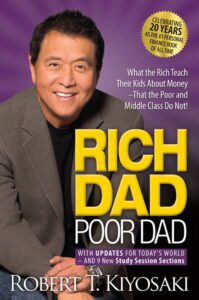
Rich Dad Poor Dad: What the Rich Teach Their Kids About Money That the Poor and Middle Class Do Not!
Author: Robert T. Kiyosaki Category: Personal Finance Publisher: Plata Publishing; Second edition (April 11, 2017) ISBN: 1612680194 Tags: finance strategies | financial goals | financial independence | financial literacy | financial wellness | investing for future | money management | money management skills | personal finance | stock investment | stock market finance | wealth creation More Details“Rich Dad Poor Dad Summary” by Robert T. Kiyosaki is a personal finance classic that revolutionizes the way readers think about money, investing, and achieving financial freedom.
In this rich dad poor dad summary, through captivating anecdotes and insightful lessons, Kiyosaki contrasts the financial philosophies of his “rich dad” and “poor dad” to highlight the crucial mindset shifts and strategies needed to build wealth.

Chapter 1: Rich Dad, Poor Dad
Kiyosaki introduces his two father figures, his biological “poor dad” – a highly educated man with a steady job but a conventional financial outlook – and his best friend’s “rich dad,” an entrepreneur with a unique perspective on money. The central theme of the book is introduced: the different approaches to financial education and wealth accumulation of rich dad poor dad pdf.
Chapter 2: The Rich Don’t Work for Money
Kiyosaki emphasizes the importance of financial education and learning to make money work for you instead of working for money. He discusses how the rich focus on acquiring assets that generate passive income, whereas the poor and middle class rely on earned income of rich dad poor dad summary.
Chapter 3: Why Teach Financial Literacy?
The chapter highlights the shortcomings of traditional education, which often neglects financial education. Kiyosaki explains how this education gap contributes to the cycle of financial struggles for many people. He underscores the significance of self-education and a proactive approach to learning about the money of rich dad poor dad pdf.
Chapter 4: Mind Your Own Business
Here, Kiyosaki emphasizes the value of entrepreneurship and building one’s own business as a pathway to financial independence. He contrasts this with the security of a job and highlights the difference between being an employee and being a business owner.
Chapter 5: The History of Taxes and the Power of Corporations
Kiyosaki delves into the history of taxes and how they’ve shaped economic dynamics. He explains how the rich utilize corporations and other legal entities to minimize taxes and protect their wealth. This chapter underscores the importance of understanding tax strategies for wealth accumulation of rich dad poor dad summary.
Chapter 6: The Rich Invent Money
In this chapter, Kiyosaki discusses the concept of creativity and innovation in creating wealth. He emphasizes the need to identify opportunities and take calculated risks, such as investing in real estate or starting a business. The rich look beyond conventional options to create new sources of income.
Chapter 7: Work to Learn, Don’t Work for Money
Kiyosaki explores the idea that valuable learning comes from taking on new challenges and acquiring new skills. He encourages readers to seek out experiences that offer opportunities for personal and professional growth, even if they don’t result in immediate financial gain.
Chapter 8: Overcoming Obstacles
Kiyosaki discusses common fears and misconceptions that prevent people from pursuing financial independence. He addresses the importance of cultivating a strong mindset, perseverance, and determination in the face of challenges.
Chapter 9: Getting Started
This chapter offers practical steps to begin the journey toward financial freedom. Kiyosaki advises readers to start small, invest wisely, and continuously educate themselves. He highlights the significance of setting clear goals and taking consistent action.
Chapter 10: Still Want More? Here Are Some To Do’s
In the final chapter, Kiyosaki provides additional advice and action steps for readers to further enhance their financial literacy and embark on the path to financial abundance. He suggests seeking mentors, networking, and continuously expanding one’s financial knowledge of rich dad poor dad pdf.
Conclusion:
“Rich Dad Poor Dad” is a transformative guide that challenges conventional notions about money, work, and education. Through the contrast of his two father figures, Kiyosaki delivers a powerful message about the importance of financial literacy, entrepreneurship, and strategic investing. By understanding and applying the principles outlined in the book, readers can reshape their financial future and strive toward lasting wealth and freedom. Embracing the mindset shifts presented in “Rich Dad Poor Dad” is a vital step towards achieving financial enlightenment and securing a prosperous future.
